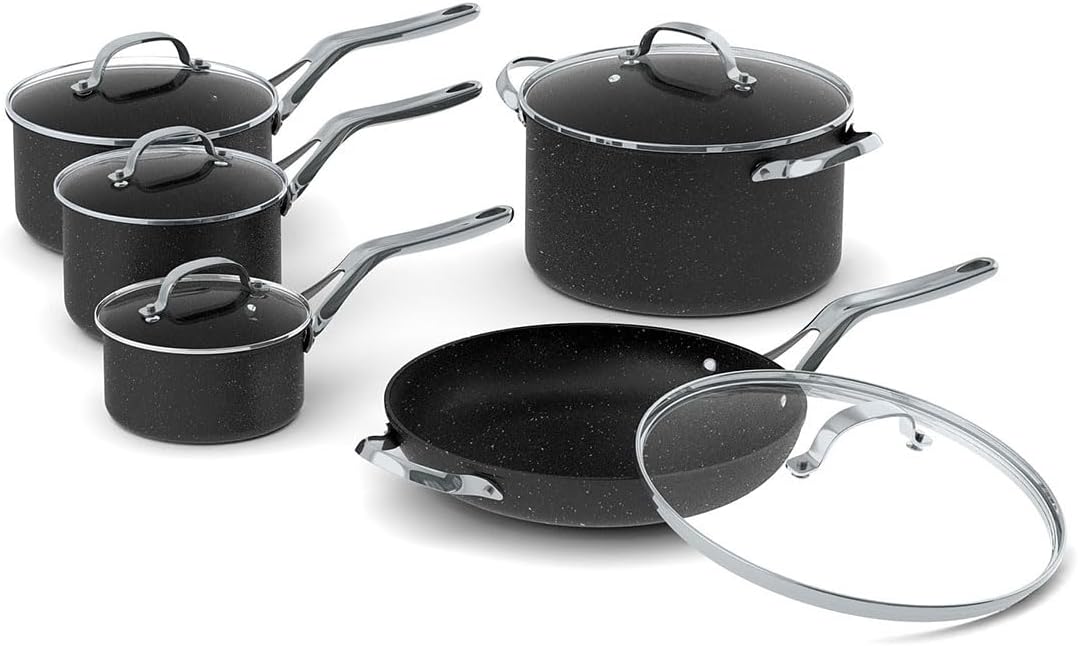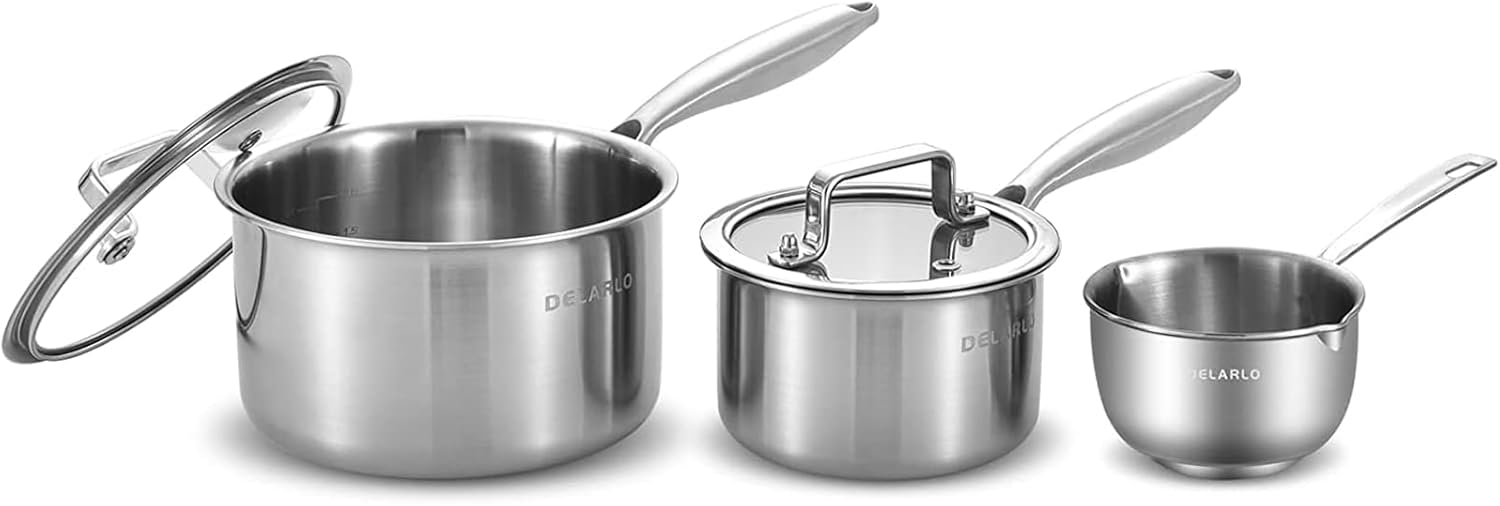Choosing the right cookware can be confusing. Cast iron and stainless steel are two popular options.
Each has its own benefits and drawbacks. Understanding these differences can help you make the best choice for your kitchen. Cast iron cookware is known for its ability to retain heat. It is great for frying and baking. On the other hand, stainless steel is praised for its durability and ease of cleaning.
It doesn’t react with food, making it safe for various recipes. By comparing these two types, you can find the one that fits your cooking style. Whether you’re a beginner or an experienced chef, knowing the strengths of each can enhance your cooking experience. Let’s dive into the details of cast iron versus stainless steel cookware.
Credit: www.abc.net.au
Cast Iron And Stainless Steel: The Basics
Choosing between cast iron and stainless steel cookware can be confusing. Each type has unique qualities. Understanding these basics will help you make the right choice for your kitchen.
Key Characteristics Of Cast Iron
Cast iron cookware is known for its durability and heat retention. Here are some key characteristics:
- Heat Retention: Cast iron holds heat well. It cooks food evenly.
- Durability: This cookware lasts a long time. With proper care, it can last for generations.
- Seasoning: Cast iron needs seasoning. This adds a non-stick layer and enhances flavor.
- Weight: It is heavy. This can make it harder to handle.
- Versatility: Use it on the stove, in the oven, or over a campfire.
Essential Properties Of Stainless Steel
Stainless steel cookware is popular for its modern appeal. Here are its essential properties:
- Non-reactive: It doesn’t react with acidic foods. This keeps flavors pure.
- Easy to Clean: Stainless steel is simple to wash. Most pieces are dishwasher safe.
- Lightweight: It is lighter than cast iron. This makes it easier to handle.
- Durability: It resists rust and corrosion. With care, it can last a long time.
- Heat Conductivity: Stainless steel heats up quickly. It may not retain heat as well as cast iron.
Historical Evolution Of Cookware Materials
The history of cookware materials reflects human innovation. Over time, people have changed how they cook. Two important materials are cast iron and stainless steel. Each has a unique background and purpose. Understanding their evolution helps us appreciate cooking today.
Origin And Advances In Cast Iron Cookware
Cast iron cookware dates back to ancient China. People used clay molds to create cooking pots. By the 5th century, cast iron spread to Europe. It gained popularity due to its durability and heat retention.
- Early Uses: Cooking over open flames.
- Middle Ages: Heavy-duty pans for baking and frying.
- 19th Century: Mass production began in the U.S.
Today, cast iron is famous for its non-stick properties. Proper seasoning enhances its surface. Cookware enthusiasts love its ability to retain heat. This makes it perfect for frying and baking.
The Development Of Stainless Steel In The Kitchen
Stainless steel cookware emerged in the early 20th century. Scientists wanted a material that resisted rust and staining. They mixed iron with chromium and nickel. This created a strong, shiny surface.
| Year | Development |
|---|---|
| 1913 | First stainless steel discovered. |
| 1920s | Stainless steel cookware became popular. |
| 1940s | Widespread use in homes and restaurants. |
Stainless steel cookware is easy to clean. It does not react with food. This ensures flavors stay pure. Many chefs prefer it for sautéing and boiling. Its sleek design adds elegance to kitchens.
Heat Conductivity And Distribution
Heat conductivity and distribution are key factors in cookware performance. These qualities affect cooking time, heat control, and flavor. Understanding how different materials manage heat helps in choosing the right cookware.
How Cast Iron Manages Heat
Cast iron is known for its excellent heat retention. It takes time to heat up but holds heat well. Here are some features:
- Even Heating: Cast iron provides uniform heat across the surface.
- High Heat Capacity: It stays hot longer, perfect for searing meats.
- Versatility: Suitable for stovetop and oven use.
Cooking with cast iron can enhance flavors. It allows for slow cooking and browning. The heat distribution helps in achieving a perfect crust on food.
Stainless Steel’s Response To Heat
Stainless steel cookware heats quickly. It does not retain heat like cast iron. Here are the main points:
- Fast Heating: Heats up quickly for quick cooking.
- Responsive: Changes temperature rapidly, ideal for delicate dishes.
- Durability: Resists warping and scratching.
Stainless steel can create hot spots. This makes it important to stir food often. It works best for sautéing and boiling.
| Feature | Cast Iron | Stainless Steel |
|---|---|---|
| Heat Retention | Excellent | Poor |
| Heating Speed | Slow | Fast |
| Heat Distribution | Even | Variable |
| Best Use | Slow cooking, baking | Sautéing, boiling |
Durability And Longevity In The Kitchen
Choosing the right cookware is important for every home chef. Two popular options are cast iron and stainless steel. Both materials have unique properties that affect their durability and longevity. Understanding these can help you make the best choice for your kitchen.
Lifespan Of Cast Iron Cookware
Cast iron cookware is known for its long lifespan. With proper care, it can last for generations. Here are some key points about cast iron durability:
- Highly durable and resistant to wear.
- Can withstand high temperatures.
- Improves with age if maintained well.
- Can develop a natural non-stick surface.
Regular seasoning helps prevent rust. Store it in a dry place. This simple care keeps your cast iron cookware looking great.
Endurance Of Stainless Steel Utensils
Stainless steel cookware offers a different kind of strength. It is also known for its endurance. Here are some facts about stainless steel:
- Resistant to rust and corrosion.
- Durable against scratches and dents.
- Safe for high-heat cooking.
- Maintains appearance over time.
Stainless steel does not require special care. A simple wash will keep it clean. This makes it easy to use in daily cooking.
| Cookware Type | Lifespan | Care Requirements |
|---|---|---|
| Cast Iron | Generational | Regular seasoning and dry storage |
| Stainless Steel | Lifetime | Simple washing, no special care |
Ease Of Maintenance And Care
Maintaining cookware can feel overwhelming. Cast iron and stainless steel each have their own care requirements. Understanding these differences can help you choose the right one for your kitchen.
Cleaning And Seasoning Cast Iron
Cast iron cookware needs special care. Proper cleaning and seasoning help it last longer. Here are some tips:
- Clean immediately after use. Avoid soaking in water.
- Use a stiff brush or sponge to remove food.
- For stuck-on food, use coarse salt as an abrasive.
- Rinse with hot water and dry thoroughly.
- Season your pan regularly to maintain its non-stick surface.
To season:
- Apply a thin layer of vegetable oil.
- Heat the pan upside down in the oven.
- Let it cool before storing.
Following these steps keeps your cast iron cookware in great shape.
Caring For Stainless Steel: Tips And Tricks
Stainless steel cookware is easier to maintain than cast iron. Here are some care tips:
- Wash with warm, soapy water after each use.
- Use a non-abrasive sponge to avoid scratches.
- For tough stains, a mixture of baking soda and water works well.
To prevent food from sticking:
- Preheat the pan before adding oil.
- Let food cook without moving it too soon.
Store your stainless steel cookware in a dry place. This helps prevent spots and discoloration. Regular care makes it shine and last.

Credit: www.youtube.com
Cooking Performance And Versatility
Choosing between cast iron and stainless steel cookware affects your cooking. Each type has unique features that impact performance and versatility. Understanding these differences helps you make better choices in the kitchen.
Cooking With Cast Iron: Pros And Cons
Cast iron cookware is known for its heat retention. It heats evenly, making it great for frying and baking. Here are some pros and cons:
| Pros | Cons |
|---|---|
|
|
Cast iron is perfect for searing meats and baking cornbread. It works on all heat sources, including ovens and grills. Regular maintenance is key to keep it in good shape.
The Flexibility Of Stainless Steel In Cooking
Stainless steel cookware offers great flexibility. It heats quickly and provides even cooking. Here are some key points:
- Lightweight and easy to handle
- Non-reactive with acidic foods
- Dishwasher safe for easy cleaning
- Ideal for sautéing, boiling, and simmering
Stainless steel is great for everyday cooking. It can handle high temperatures without warping. This type of cookware is perfect for sauces and stir-frying. It also looks stylish in any kitchen.
Both cast iron and stainless steel have their strengths. Choose based on your cooking style and needs.
Health And Safety Considerations
Choosing between cast iron and stainless steel cookware involves health and safety. Both materials have their benefits and risks. Understanding these factors helps you make a safe choice for your kitchen.
Is Cooking With Cast Iron Safe?
Cooking with cast iron is generally safe. Many people use it every day. However, there are some important points to note:
- Iron Leaching: Cast iron can release small amounts of iron into food. This is usually safe and can even be beneficial for those who need more iron.
- Seasoning: Proper seasoning creates a natural non-stick surface. It also prevents rust. Use vegetable oil or animal fat for best results.
- High Heat: Cast iron withstands high heat. However, do not leave empty pans on high heat. This can cause them to warp or crack.
People with certain health conditions should be cautious. Excessive iron intake can harm those with conditions like hemochromatosis. Always consult a doctor if unsure.
Health Impacts Of Using Stainless Steel
Stainless steel cookware is popular and often considered safe. It does not react with food. This keeps flavors intact and prevents harmful leaching.
Consider the following points:
- Nickel Content: Some stainless steel contains nickel. This can cause allergic reactions in sensitive individuals.
- Durability: Stainless steel is resistant to rust and corrosion. It lasts a long time with proper care.
- Non-Reactive: Stainless steel does not react with acidic foods. This preserves the taste and nutrients in your meals.
Overall, stainless steel is a safe choice for most people. Always check the material used in your cookware.
Cost And Affordability
Choosing between cast iron and stainless steel cookware involves more than just cooking performance. Cost plays a big role. Understanding the price differences helps you make the best choice for your kitchen.
Investing In Cast Iron: Is It Worth It?
Cast iron cookware often has a higher upfront cost. However, it lasts a lifetime with proper care. Here are some key points:
- Prices range from $20 to over $300.
- High durability means less need for replacements.
- Excellent heat retention saves energy costs.
Consider the long-term value. A cast iron skillet can be passed down through generations. This makes it a smart investment.
Stainless Steel: Budget-friendly Or Premium Price?
Stainless steel cookware usually offers more price options. You can find affordable choices as well as high-end brands. Here’s a breakdown:
| Price Range | Quality |
|---|---|
| $20 – $100 | Good for beginners |
| $100 – $300 | Better heat distribution and durability |
| $300+ | Professional-grade quality |
Stainless steel is great for everyday cooking. It requires less maintenance than cast iron. Choose based on your cooking needs and budget.
Environmental Impact And Sustainability
The choice between cast iron and stainless steel cookware affects the planet. Each type of cookware has its own environmental footprint. Understanding this can help you make informed choices. Let’s explore how cast iron and stainless steel impact our environment.
Eco-footprint Of Cast Iron Production
Cast iron cookware is made from iron ore. The mining process is energy-intensive. It requires large amounts of energy and resources.
- Mining can cause habitat destruction.
- Transportation of raw materials increases carbon emissions.
- Manufacturing uses high temperatures, which consumes more energy.
Despite these factors, cast iron cookware lasts a long time. It can be passed down through generations. This durability reduces the need for replacements.
Stainless Steel: A Greener Option?
Stainless steel is made from iron, carbon, and other metals. The production process also has its impacts. However, it is often seen as a more sustainable choice.
- Recyclability: Stainless steel is 100% recyclable.
- Longevity: It can last many years with proper care.
- Less energy: Producing stainless steel requires less energy over time.
Choosing stainless steel can lower your eco-footprint. Many brands prioritize sustainable practices. Look for certifications that guarantee eco-friendly production.

Credit: prudentreviews.com
Culinary Experts’ Opinions And Preferences
Culinary experts often weigh in on cookware choices. Their insights help many home cooks decide between cast iron and stainless steel. Both types of cookware have their loyal followers. Understanding their preferences can guide your next purchase.
Professional Chefs’ Take On Cast Iron
Many chefs love cast iron cookware. They appreciate its ability to retain heat. This feature is vital for searing meat and baking. Here are some reasons why chefs prefer cast iron:
- Durability: Cast iron can last a lifetime with proper care.
- Versatility: It works on the stovetop and in the oven.
- Natural Non-Stick: Seasoning creates a non-stick surface.
Chefs often recommend cast iron for:
- Frying chicken
- Baking cornbread
- Searing steaks
Many chefs believe that cast iron improves with age. They find it an essential tool in their kitchens.
Why Some Chefs Favor Stainless Steel
Stainless steel cookware also has a strong following. Many chefs prefer it for specific reasons:
- Quick Heating: Stainless steel heats up quickly and evenly.
- Easy to Clean: It is dishwasher safe and resists staining.
- No Reaction: It does not react with acidic foods.
Chefs often choose stainless steel for:
- Sauteing vegetables
- Cooking sauces
- Boiling pasta
Many chefs value the lightweight design. It allows for easy handling and maneuverability.
Both cookware types have advantages. Each chef has unique preferences based on their cooking style.
Final Verdict: Which One Should You Choose?
Choosing between cast iron and stainless steel cookware can be tough. Both types have their own benefits and drawbacks. Understanding their differences helps you make the right choice for your kitchen.
Factors To Consider Before Buying
Several factors can guide your decision. Think about the following:
- Cooking Style: How do you cook? Do you prefer slow cooking or quick frying?
- Maintenance: Are you ready to care for cast iron? Or do you prefer low maintenance?
- Durability: Both types last long, but cast iron can chip.
- Heat Conductivity: Cast iron holds heat well. Stainless steel heats up quickly.
- Health Considerations: Cast iron can add iron to your food. Stainless steel does not react with acidic foods.
Making The Best Choice For Your Kitchen
Deciding on cookware depends on your needs. Here are some tips:
- If you love slow cooking: Go for cast iron.
- If you want easy cleaning: Choose stainless steel.
- If you cook a variety of dishes: Consider having both types.
- If you cook with high heat: Stainless steel may be better.
- If you want to enhance flavor: Cast iron can be a good choice.
Both cast iron and stainless steel cookware can serve you well. Weigh your options based on your cooking habits. Select the one that fits your kitchen style and needs.
Frequently Asked Questions
What Are The Pros Of Cast Iron Cookware?
Cast iron cookware offers excellent heat retention and even cooking. It’s ideal for searing meats and baking. With proper seasoning, it becomes naturally non-stick. Additionally, cast iron is incredibly durable and can last a lifetime if cared for properly. It’s also versatile for stovetop and oven use.
Is Stainless Steel Cookware Better Than Cast Iron?
Stainless steel cookware is often lighter and easier to handle. It’s non-reactive, making it perfect for acidic foods. Unlike cast iron, stainless steel doesn’t require seasoning. However, it may not retain heat as well as cast iron for certain cooking methods.
Ultimately, it depends on your cooking style.
How Do I Maintain Cast Iron Cookware?
To maintain cast iron cookware, clean it with hot water and a stiff brush. Avoid soap, as it can strip the seasoning. Dry it thoroughly to prevent rust. Reapply a thin layer of oil after each use to keep the surface non-stick.
Store it in a dry place.
Can I Use Metal Utensils On Stainless Steel?
Yes, metal utensils are safe to use on stainless steel cookware. The durable surface can withstand scratches without damage. However, be mindful of using sharp utensils, as they can leave marks. For longevity, consider using silicone or wooden utensils to maintain its appearance.
Conclusion
Choosing between cast iron and stainless steel cookware depends on your needs. Cast iron holds heat well and is great for slow cooking. It can add flavor to your meals. Stainless steel is lighter and easier to clean. It works well for quick cooking.
Both types have their strengths. Think about what you cook most often. Your choice should match your cooking style. Happy cooking, whether you go with cast iron or stainless steel!





Leave a Reply